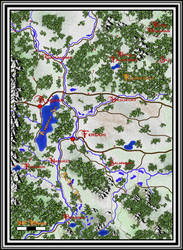Shintaro89
6 Watchers6 Deviations
3.3K
PageviewsWatchers 6
Zachary-A-Valerian
Meteox
AntiStylz-Berlin
Messerwind
EdwinaCX
Goerke
Watching 2
Tokala
Das-schwarze-Auge
Collection
Favourites
Shintaro89 is not a Group Admin yet
Groups they admin or create will appear here
- Nov 11
- Germany
- Deviant for 14 years
- He / Him
Badges

Profile Comments 12
Join the community to add your comment. Already a deviant? Log In
Happy Birthday!
Happy Birthday!
Happy Birthday!
Happy Birthday!
Say, I could use your advice. Does this sound right?
Oxidation: For example, Oxygen can be used to remove Electrons from Iron (Fe).
This is because Oxygen needs 2 Electrons to make itself stable, so it has an electric charge of -2.Iron oxide: Iron (Fe) has an oxidation state ranging from -2 to +6 (Although +2 and +3 are the most common).
Iron oxides are chemical compounds composed of Iron and oxygen. Rust is a form of Iron(III) oxide [00].
You cannot have an oxidation reaction without a corresponding reduction reaction [00].Rrusting: (Fe) + -nH2O + O2 (e4-) → (Fe)2O3
The release of Electrons causes a small current to flow in the (Fe) [00].(Fe)2 + O24- → (e4-)Type 1: (Fe)2 + O2 (e4-) → [ (Fe)1O2+4 ] + [ (Fe)1 ]Reduction (Redox): Oxygen is reduced (gains e-)
Type 1: (Fe)2 + O2 (e4-) → [ (Fe)1O1+2 ] + [ (Fe)1O1+2 ]
(e4-) + 2 H2O + O22- → [ OH2- ] + [ OH2- ] + [ O22- ]Type 1: (e4-) + O24- + H4 → [ H2O ] + [ H2O ]
Type 2: (e4-) + O24- + H2 → [ H2O ] + [ O1 ]
Type 3: (e4-) + O24- + H2 + H2O → [ O22- ] + [ H2O ] + [ H2 ]
Personally, I would start with a formal definition of oxidation since the present of oxygen isn't necessary: "a redox reaction is a reaction that changes the electron configuration of two ore more elements. The element that formally gaines electrons is reduced, the element that loses electrons is oxidated."
For the example I would suggest to use both arabic numbers for real charges (-2) and roman numbers for oxidation states (+II).
And last about your example: rust is a non-stoichiometric compound, I think it's best described as a mixture of Fe2O3, Fe2O2(OH)2 and Fe2O2(OH) - but that's too much detail. In the end your reaction formulas are quiet confusing.
I'd write the reaction like this:
4 Fe + 3 O2 --> 2 Fe2O3
Or, if you want to split it up:
oxidation: Fe --> Fe(3+) + 3 e(-)
reduction: O2 + 4 e(-) --> 2 O(2-)
---------------------------------------------
combined: 4 Fe + 3 O2 --> 2 Fe2O3
For the example I would suggest to use both arabic numbers for real charges (-2) and roman numbers for oxidation states (+II).
And last about your example: rust is a non-stoichiometric compound, I think it's best described as a mixture of Fe2O3, Fe2O2(OH)2 and Fe2O2(OH) - but that's too much detail. In the end your reaction formulas are quiet confusing.
I'd write the reaction like this:
4 Fe + 3 O2 --> 2 Fe2O3
Or, if you want to split it up:
oxidation: Fe --> Fe(3+) + 3 e(-)
reduction: O2 + 4 e(-) --> 2 O(2-)
---------------------------------------------
combined: 4 Fe + 3 O2 --> 2 Fe2O3
Thank you. While I wasn't able to describe how (Fe) induces an electric current to create Rust, this still helps me clear up some details.

















